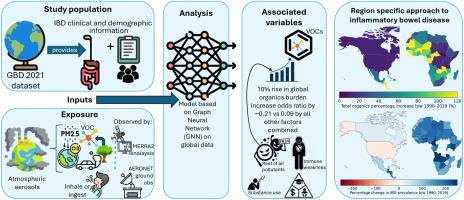Deep neural networks reveal organic pollutants’ dominance in global inflammatory bowel disease
IF 6.3
2区 环境科学与生态学
Q1 ENVIRONMENTAL SCIENCES
引用次数: 0
Abstract
Inflammatory bowel disease (IBD) is increasing globally, with risk factors still poorly understood and influenced by both genetic and environmental factors. The role of atmospheric pollutants, particularly precursor organic pollutants contributing to < 2.5 µm size particulate matter (PM2.5), remains unclear. In this multi-decadal global study, we investigated their contribution to IBD prevalence using data from the Global Burden of Disease (GBD, 1990–2019), NASA’s MERRA-2, and AERONET datasets. A graph neural network (GNN) modeled spatio-temporal dependencies and incorporated immune dysfunction and socio-economic disparities. The dataset was split into 75 % training and 25 % testing, achieving mean squared errors of 4.3 % and 4.6 % respectively, with strong predictive validity (R2 = 0.87). A 10 % global increase in organics was associated with a rise in odds ratio (OR) by 0.21 (95 % CI: 0.12–0.29, p < 0.001), compared to a smaller OR increase of 0.04 (95 % CI: 0.01–0.09, p < 0.001) for PM2.5. Regional disparities were evident, with Sub-Saharan Africa exhibiting higher odds ratios (OR = 1.25; 95 % CI: 1.09–1.43, p < 0.01) than North America (OR = 1.08; 95 % CI: 1.03–1.24, p < 0.05) at an organic burden of 5 µg/m³. However, this trend reversed at higher exposure (25 µg/m³), where the OR for North America approaches 2, while Sub-Saharan Africa plateaued near 1.5. Notably, particles under 100 nm posed the greatest risk. Concluding, organic pollutants play a disproportionate and size-dependent role in IBD prevalence, with significant regional variability. This underscores the need to consider organics as a distinct environmental risk factor in IBD epidemiology.

深度神经网络揭示了有机污染物在全球炎症性肠病中的主导地位
炎症性肠病(IBD)正在全球范围内增加,其风险因素仍然知之甚少,并受到遗传和环境因素的影响。大气污染物,特别是前体有机污染物对2.5µm大小的颗粒物(PM2.5)的作用尚不清楚。在这项数十年的全球研究中,我们使用来自全球疾病负担(GBD, 1990-2019)、美国宇航局MERRA-2和AERONET数据集的数据调查了它们对IBD患病率的贡献。图神经网络(GNN)模拟了时空依赖性,并纳入了免疫功能障碍和社会经济差异。数据集分为75%的训练和25%的测试,均方误差分别为4.3%和4.6%,预测效度较强(R2 = 0.87)。全球有机物增加10%与比值比(OR)增加0.21相关(95% CI: 0.12-0.29, p < 0.001),而PM2.5的比值比(OR)增加较小,为0.04 (95% CI: 0.01-0.09, p < 0.001)。区域差异很明显,在有机负荷为5µg/m³时,撒哈拉以南非洲的优势比(OR = 1.25; 95% CI: 1.09-1.43, p < 0.01)高于北美(OR = 1.08; 95% CI: 1.03-1.24, p < 0.05)。然而,这一趋势在较高的暴露(25微克/立方米)下发生逆转,北美的OR接近2,而撒哈拉以南非洲的OR稳定在1.5附近。值得注意的是,100纳米以下的颗粒风险最大。综上所述,有机污染物在IBD患病率中发挥了不成比例的作用,并且具有显著的区域差异。这强调有必要将有机物视为IBD流行病学中一个独特的环境风险因素。
本文章由计算机程序翻译,如有差异,请以英文原文为准。
求助全文
约1分钟内获得全文
求助全文
来源期刊

Journal of Environmental Sciences-china
环境科学-环境科学
CiteScore
13.70
自引率
0.00%
发文量
6354
审稿时长
2.6 months
期刊介绍:
The Journal of Environmental Sciences is an international journal started in 1989. The journal is devoted to publish original, peer-reviewed research papers on main aspects of environmental sciences, such as environmental chemistry, environmental biology, ecology, geosciences and environmental physics. Appropriate subjects include basic and applied research on atmospheric, terrestrial and aquatic environments, pollution control and abatement technology, conservation of natural resources, environmental health and toxicology. Announcements of international environmental science meetings and other recent information are also included.
 求助内容:
求助内容: 应助结果提醒方式:
应助结果提醒方式:


